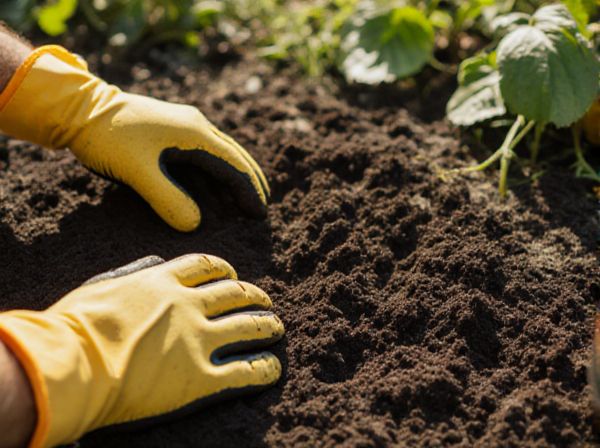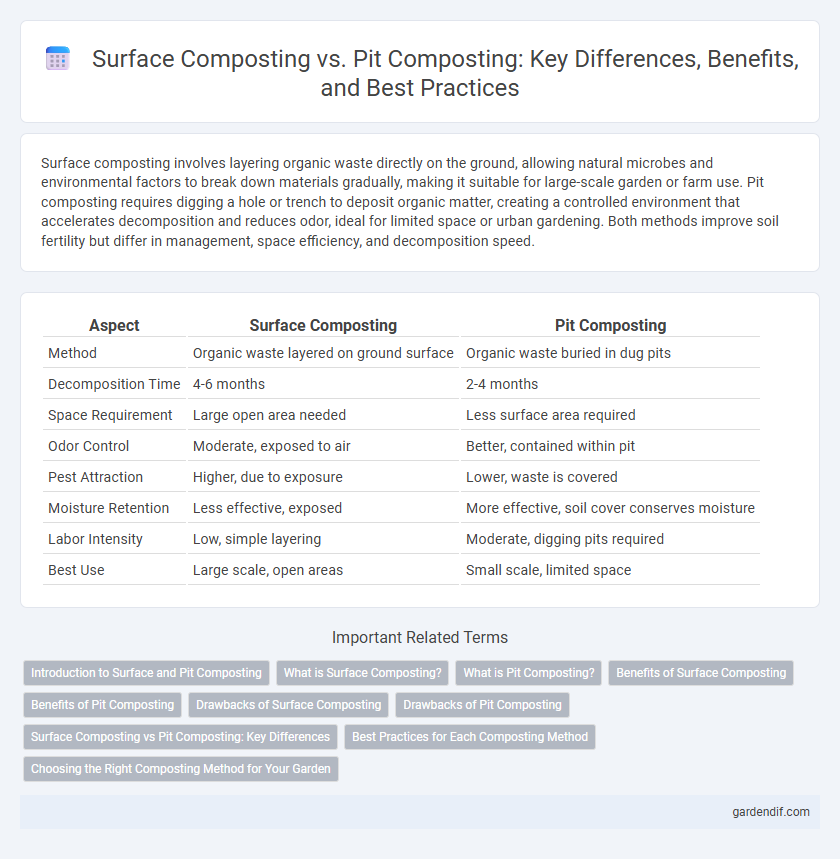
Surface Composting vs Pit Composting Illustration
Surface composting involves layering organic waste directly on the ground, allowing natural microbes and environmental factors to break down materials gradually, making it suitable for large-scale garden or farm use. Pit composting requires digging a hole or trench to deposit organic matter, creating a controlled environment that accelerates decomposition and reduces odor, ideal for limited space or urban gardening. Both methods improve soil fertility but differ in management, space efficiency, and decomposition speed.
Table of Comparison
| Aspect | Surface Composting | Pit Composting |
|---|---|---|
| Method | Organic waste layered on ground surface | Organic waste buried in dug pits |
| Decomposition Time | 4-6 months | 2-4 months |
| Space Requirement | Large open area needed | Less surface area required |
| Odor Control | Moderate, exposed to air | Better, contained within pit |
| Pest Attraction | Higher, due to exposure | Lower, waste is covered |
| Moisture Retention | Less effective, exposed | More effective, soil cover conserves moisture |
| Labor Intensity | Low, simple layering | Moderate, digging pits required |
| Best Use | Large scale, open areas | Small scale, limited space |
Introduction to Surface and Pit Composting
Surface composting involves decomposing organic waste in an open heap on the ground, promoting aerobic microbial activity through regular aeration and moisture control. Pit composting entails burying organic materials in a dug-out pit, creating a controlled environment that accelerates decomposition by retaining heat and moisture while minimizing odor and pest issues. Both methods efficiently recycle organic matter but vary in space requirements, management intensity, and suitability for different types of waste.
What is Surface Composting?
Surface composting is a method where organic waste materials are layered on top of the soil and allowed to decompose naturally. This technique promotes aerobic microbial activity by maintaining adequate moisture and oxygen exposure on the compost surface. Surface composting is ideal for managing garden waste and crop residues without the need for excavation.
What is Pit Composting?
Pit composting involves decomposing organic waste in a dug hole or trench, where microorganisms break down materials under controlled moisture and aeration conditions. This method allows better retention of nutrients and reduces odor by limiting exposure to air compared to surface composting. Farmers and gardeners prefer pit composting for efficient nutrient recycling and improved soil fertility in small-scale settings.
Benefits of Surface Composting
Surface composting enhances aeration and moisture retention, promoting faster microbial activity and decomposition. This method reduces labor intensity by eliminating the need for digging, making it ideal for large-scale agricultural applications. Surface composting also minimizes nutrient loss and supports soil structure improvement, leading to healthier crop growth.
Benefits of Pit Composting
Pit composting enhances nutrient retention by minimizing exposure to air, resulting in richer, more balanced organic matter fertilizer. It optimizes moisture levels and temperature stability, accelerating microbial activity and decomposition rates compared to surface composting. This method also reduces pest attraction and nutrient leaching, promoting sustainable soil health and higher crop yields.
Drawbacks of Surface Composting
Surface composting often leads to significant nutrient loss due to exposure to wind and rain, which can wash away essential minerals and organic matter. It also attracts pests and animals more easily, increasing the risk of contamination and disturbance to the composting material. Furthermore, surface compost piles tend to dry out quickly, hindering microbial activity and slowing down the decomposition process.
Drawbacks of Pit Composting
Pit composting often faces challenges such as poor aeration, which slows down microbial activity and extends decomposition time. Limited oxygen flow in the pit can lead to anaerobic conditions, causing unpleasant odors and incomplete composting. Furthermore, the confined space in pits may attract pests and rodents, leading to hygiene concerns and potential contamination.
Surface Composting vs Pit Composting: Key Differences
Surface composting involves spreading organic waste in layers on the ground, allowing aerobic decomposition primarily driven by microorganisms and oxygen exposure. Pit composting requires digging a pit where organic materials decompose anaerobically, often resulting in slower breakdown and different microbial activity due to limited oxygen. Key differences include decomposition speed, oxygen availability, space requirements, and ease of management, with surface composting favoring faster, more aerobic processes and pit composting offering controlled, less space-intensive decomposition.
Best Practices for Each Composting Method
Surface composting requires maintaining a consistent moisture level by regularly turning the organic material and layering with carbon-rich and nitrogen-rich components to promote aeration and microbial activity. Pit composting benefits from proper sizing of the pit, thorough mixing of materials to balance green and brown waste, and covering the pit with soil or mulch to retain heat and moisture, accelerating decomposition. Both methods demand monitoring temperature and moisture levels to optimize microbial efficiency and produce high-quality compost.
Choosing the Right Composting Method for Your Garden
Surface composting is ideal for gardeners with limited space or those seeking a low-maintenance option, allowing organic waste to decompose directly on the soil surface, enriching topsoil and improving moisture retention. Pit composting involves burying organic matter in a dug hole, offering faster decomposition and better odor control, making it suitable for larger gardens or areas where aesthetics and pest management are priorities. Selecting the right composting method depends on garden size, waste volume, and desired decomposition speed, ensuring optimal nutrient recycling and soil health enhancement.
Surface Composting vs Pit Composting Infographic

 gardendif.com
gardendif.com